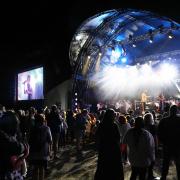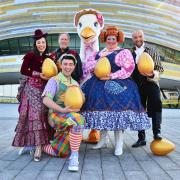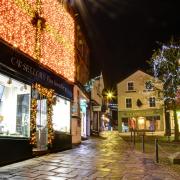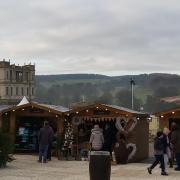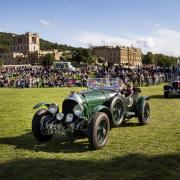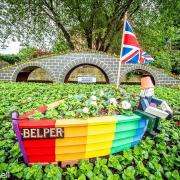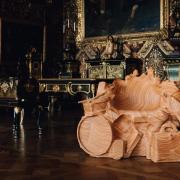It’s the biggest racing day in the region and when 18 runners and riders line-up for the Midlands Grand National it will be up to Ashbourne’s Charlie Moore to make sure that it all goes off smoothly. Nigel Powlson walks Uttoxeter Racecourse with Charlie as his guide

On 14th March, as up to 16,000 enthusiasts descend on Uttoxeter Racecourse for the second-longest steeplechase in the country, Derbyshire’s Charlie Moore will have every right to be anxious.
This may be the 14th time he has been involved with the race, and his sixth as senior clerk of the course, but with packed stands, a £100,000 prize pot and the entire racing world’s attention on the most prestigious day in Uttoxeter’s calendar, there’s a lot riding on the event’s success and much of the responsibility falls on Charlie’s shoulders.
‘Like anything in life, if it doesn’t tighten your cheeks a bit you are not on top form,’ he says. ‘In many ways you are only doing what you are doing the meeting before, but there are more horses running, better horses running, and you have an awful lot more people watching. There’s also the pressure of extra media interest.’
When Charlie wakes up in his home in Ashbourne and gets ready for the big day, the one thing that’s out of his control is the weather, which in March can be anything from blizzards to sunshine – the race was called off in 2004 because of ferocious gales which made the course unsafe for horses and spectators alike.

‘Before I have eaten my porridge in the morning I will have looked at at least five weather reports,’ says Charlie. ‘We have a retained forecasting company based at the University of East Anglia and we can ring them up anytime of the day for an update. But there is only so much we can do to mitigate against the weather.’
When Derbyshire Life catches up with Charlie he’s preparing for a race day in January at the end of a bitterly cold week which has delivered more than its fair share of sleet and rain. We walk the course together and he explains how he’s attempting to protect the circuit that will be used in the Midlands Grand National whilst still ensuring good racing at the meets leading up to it.
He says: ‘From September, when we start racing after the summer break, we have in mind where we will run the Midlands Grand National. Because we are racing 25 times a year we can do a lot of damage and, because that’s our most prestigious race, we want to give it the best possible ground. They are racing for the biggest prize in our calendar.’
Uttoxeter Racecourse dates back more than 100 years, on a site that has also housed rugby and football pitches and which still hosts cricket. Uttoxeter is a left-handed circuit, although the far side has a dog leg to the right. It’s just over one mile two furlongs round, with a chute that’s used for two mile races. Many people think it is flat but once you are out on the course you notice the undulations and the rise over the steepest part, known as Clump Hill. There used to be a water jump but it could barely be seen from the grandstand and as Charlie says ‘no trainers have one to practice over’, so it was taken out.

It’s heavy clay land at Uttoxeter and it takes miles of drains under the course to stop it getting waterlogged.
Charlie points out a fence that’s on a plinth, which was constructed to elevate it out of the mud.
He says: ‘It was built in the 1980s and the idea was that at least the horses took off and landed on dry land. People used to race in quite appalling conditions. We don’t do that anymore, it’s not a great spectacle. If you think back to pictures of George Best scoring a goal, it’s invariably on a muddy pitch. Wayne Rooney is always on grass. Likewise, we have moved on. We know a lot more about what we are doing. It’s not just about drains. It’s about the structure of the top soil as well.’
The Midlands Grand National is one of the most prestigious races on the national hunt calendar. The Aintree Grand National is longer and is the one that everyone wants to win. Cheltenham happens the same week, but although that might seem to suggest that Uttoxeter is in its shadow, it does have the benefit of focusing the nation on racing and boosting the turn out come the Saturday of that week when attention turns to Staffordshire.

So where does Charlie think the race stands in terms of prestige?
He says: ‘It always has a full field of 20, and horses have to be eliminated. We also have two reserves. That means that the race is always as competitive as it can be. There’s decent prize money and the trainers want to run in it. It may be small change compared with winning the Grand National but there is only one Grand National. It’s quite a bit less than the Cheltenham Gold Cup but it fairs very well against many of the handicaps at Cheltenham. The Scottish Grand National has a lot of money thrown at it by Ayr racecourse and there’s the Welsh Grand National, but of all the regional nationals, we top those very comfortably. Ours is also in the Jump Pattern, which means races have got a preserved heritage and you can’t change them without the permission of the British Horse Racing Authority – it’s their race as well as ours. We also work hard to make the supporting card as good as we can. It really is the day when racing comes to town.’
There are 24 fences on the four miles and one furlong course, they are 4ft 6ins high and the widest is the open ditch which has an eight feet clearance. It’s a stern test of both rider and horse. It’s also a thrilling spectacle.
Charlie says: ‘Horses don’t get the chance to run over extreme distances that often; they don’t get to run for a prize fund of £100,000 every day of the week; they don’t get to race in front of 13-16,000 people very often. It’s a great event and we are as busy, as vibrant and as packed as Cheltenham is for four days, but in our own way.’
Richard Johnson won the race last year on ‘Goulanes’. But Charlie’s top winner was AP McCoy on ‘Synchronised’ in 2010. ‘That’s the best horse that ever won the Midlands Grand National,’ he says. ‘He went on to win the Cheltenham Gold Cup and is the highest rated horse ever to run here. “Lord Gyllene” finished second here and then won the Grand National in 1997 – and he was owned by Stan Clarke who bought the course here in 1988, so we have a soft spot for him.’
There’s a lot to do to make sure 14th March is as memorable, so how would Charlie sum up his responsibilities?
‘To set it all up and then run it, working within all the rules and regulations,’ he says. ‘I’m rather like the ringmaster and I’m absolutely fine when things are going well. I wander round with my binoculars, radio and mobile phone and haven’t got a care in the world. The moment the big top falls down, that’s when I earn my money. You have to be pretty good at crisis management. I have a great team out on the course while I’m in the stands watching. I can’t get to every fence, I have to rely on them and they are trained and rehearsed in what they do, whether they are a groundsman, a paramedic or a vet. It’s my job to hold it all together.’
As the sun peeks through the January mist and we walk towards the finishing line, it’s not hard to imagine the atmosphere of race day with crowds flanking each side of the course, cheering their favourites home.
Charlie says: ‘The ultimate satisfaction for me is being pleased with the layout of the racecourse and the presentation of it on the day, the state of the going and then having a day where no jockey and no horse are injured and the racing is good and competitive. At the end of a day like that you get a real buzz out of it.’
The big day
Since 1969, the Betfred Midlands Grand National has been the jewel in the crown of the region’s horse racing. This year’s race takes place on 14th March and there are eight races including the big one.
Tickets range from £14 for centre course to £37 for the Premier Plus package. Go to www.uttoxeter-racecourse.co.uk






